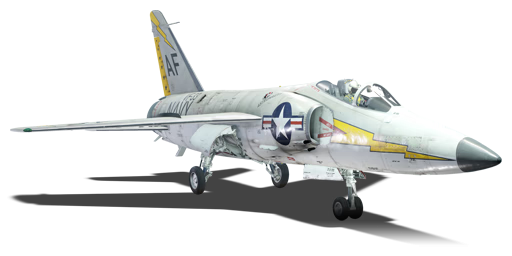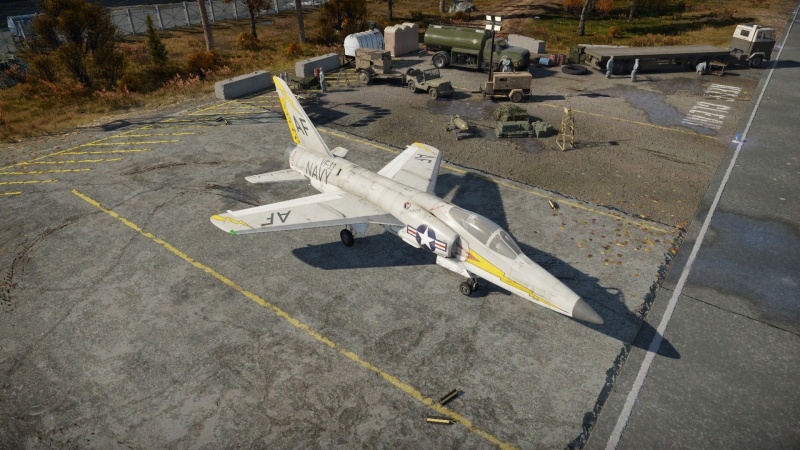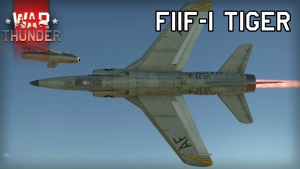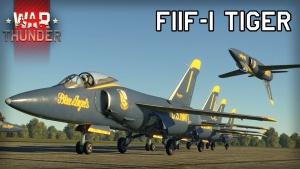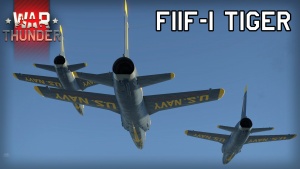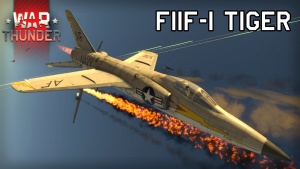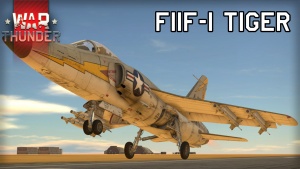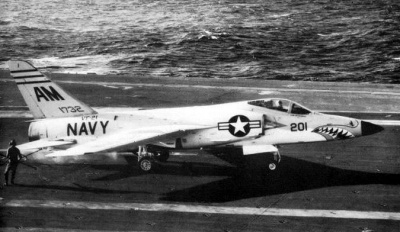Difference between revisions of "F11F-1"
(→Suspended armament: Updated) |
bacongaming (talk | contribs) (→Flight performance: added ingame screenshots.) (Tag: Visual edit) |
||
| Line 13: | Line 13: | ||
=== Flight performance === | === Flight performance === | ||
{{Specs-Avia-Flight}} | {{Specs-Avia-Flight}} | ||
| − | <!-- ''Describe how the aircraft behaves in the air. Speed, manoeuvrability, acceleration and allowable loads - these are the most important characteristics of the vehicle.'' --> | + | <!-- ''Describe how the aircraft behaves in the air. Speed, manoeuvrability, acceleration and allowable loads - these are the most important characteristics of the vehicle.'' -->[[File:F11F-1 Wiki Image 5.jpg|thumb|Top view of the F11F-1.]] |
| − | |||
The F11F-1 Tiger is a supersonic carrier-based jet fighter equipped with the Allison J65-W-18 engine. The plane is able to reach Mach 1 speed in level speed, making it one of the fastest planes at its battle rating, but getting it past that speed will require some diving. Because of the very high structural speed limit, it basically can dive with an afterburner at any angle and the player will only have to worry about very high speed (past mach 1) compression. | The F11F-1 Tiger is a supersonic carrier-based jet fighter equipped with the Allison J65-W-18 engine. The plane is able to reach Mach 1 speed in level speed, making it one of the fastest planes at its battle rating, but getting it past that speed will require some diving. Because of the very high structural speed limit, it basically can dive with an afterburner at any angle and the player will only have to worry about very high speed (past mach 1) compression. | ||
While other United States supersonic jet fighters like a F-100 or F3H are better at it, the acceleration is decent for this type of plane. The other planes that it will meet at its battle rating will struggle to keep up with it, for example the MiG-17AS, Shenyang F-5 or the German CL-13B Mk.6, especially when the Tiger is flying with 20 or less minutes of fuel. | While other United States supersonic jet fighters like a F-100 or F3H are better at it, the acceleration is decent for this type of plane. The other planes that it will meet at its battle rating will struggle to keep up with it, for example the MiG-17AS, Shenyang F-5 or the German CL-13B Mk.6, especially when the Tiger is flying with 20 or less minutes of fuel. | ||
| Line 22: | Line 21: | ||
Its roll rate is as good as in the F-86 series: it can reach up to ~250 degrees per second at its optimal speed, that can make it very hard for the enemy to land some hits on it and make it easier to force the enemy to overshoot. | Its roll rate is as good as in the F-86 series: it can reach up to ~250 degrees per second at its optimal speed, that can make it very hard for the enemy to land some hits on it and make it easier to force the enemy to overshoot. | ||
The airbrake on this plane is effective only above a certain speed and not so effective during landing. It makes the plane very hard to slow down in a straight line flight because it can not be used when the landing gear is extended. Using flaps will also not help that much in that situation and since it can be deployed in one position, the one for landing, its usefulness in combat situations is questionable. | The airbrake on this plane is effective only above a certain speed and not so effective during landing. It makes the plane very hard to slow down in a straight line flight because it can not be used when the landing gear is extended. Using flaps will also not help that much in that situation and since it can be deployed in one position, the one for landing, its usefulness in combat situations is questionable. | ||
| − | + | [[File:F-11F1 Wiki Image 1.jpg|thumb|A group of F-11F-1's ready for take off.]] | |
In simulator battles, the F11 can fly at much higher angles than with the enabled instructor, making it more capable at high angle attacks and snapshots, but it can also lead to a broken wing if the speed is too high. The other downside is an even further decreased turning energy retention which is already quite mediocre at low and medium speeds. | In simulator battles, the F11 can fly at much higher angles than with the enabled instructor, making it more capable at high angle attacks and snapshots, but it can also lead to a broken wing if the speed is too high. The other downside is an even further decreased turning energy retention which is already quite mediocre at low and medium speeds. | ||
| Line 113: | Line 112: | ||
|- | |- | ||
|} | |} | ||
| + | |||
| + | [[File:F11F-1 Wiki Image 4.jpg|thumb|A group of F11F-1's in a formation.]] | ||
=== Survivability and armour === | === Survivability and armour === | ||
| Line 135: | Line 136: | ||
* 4 x 20 mm Browning-Colt Mk12 Mod 0 cannons, -mounted (125 rpg = 500 total) | * 4 x 20 mm Browning-Colt Mk12 Mod 0 cannons, -mounted (125 rpg = 500 total) | ||
| + | |||
| + | [[File:F11F-1 Wiki Image 6.jpg|thumb|F11F-1 after using its four 20mm Cannons.]] | ||
=== Suspended armament === | === Suspended armament === | ||
| Line 168: | Line 171: | ||
Against the MiG-15 and 17 and other similar jets without missiles, the best tactics is just to either boom and zoom them, or in the defensive situation to start running in a straight line, get some distance between two planes, then use the superior climb rate to get above it and proceed to boom and zooming the enemy. Any dogfighting will end up very badly: its very bad turning energy retention when the plane starts flying at high angle of attack and worse sustained turn rate will lead to losing the fight in a few seconds. | Against the MiG-15 and 17 and other similar jets without missiles, the best tactics is just to either boom and zoom them, or in the defensive situation to start running in a straight line, get some distance between two planes, then use the superior climb rate to get above it and proceed to boom and zooming the enemy. Any dogfighting will end up very badly: its very bad turning energy retention when the plane starts flying at high angle of attack and worse sustained turn rate will lead to losing the fight in a few seconds. | ||
| − | + | [[File:F11F-1 Wiki Image 2.jpg|thumb|F11F-1 shooting down a [[Tu-4]].]] | |
When fighting the Shenyang F-5 or MiG-17AS or any other planes with missiles, it is best to not allow them to get behind the Tiger (your excellent cockpit visibility will help you detect when it happens). While they can be avoided, it is still risky and can lead to the plane slowing down and becoming an easy target for higher manoeuvrable fighters. One of the tactics is to make the enemy waste all his missiles by baiting them into launching the missile by running away and pulling a few G (depends on the speed, 4-5G works at ~700 km/h TAS, at higher speed you need more G), then avoiding them. For example both MiG-17 variants are able to carry only two of them. Once they run out of missiles, deal with them like with any other jet fighter. The only exception is the Yak-38: it also carries the R-60 missiles which have much higher tracking ability and can pull much more G but its manoeuvrability is even worse, so it can be outturned in any situation, especially after forcing it to prolonged turning: its energy retention is awful. | When fighting the Shenyang F-5 or MiG-17AS or any other planes with missiles, it is best to not allow them to get behind the Tiger (your excellent cockpit visibility will help you detect when it happens). While they can be avoided, it is still risky and can lead to the plane slowing down and becoming an easy target for higher manoeuvrable fighters. One of the tactics is to make the enemy waste all his missiles by baiting them into launching the missile by running away and pulling a few G (depends on the speed, 4-5G works at ~700 km/h TAS, at higher speed you need more G), then avoiding them. For example both MiG-17 variants are able to carry only two of them. Once they run out of missiles, deal with them like with any other jet fighter. The only exception is the Yak-38: it also carries the R-60 missiles which have much higher tracking ability and can pull much more G but its manoeuvrability is even worse, so it can be outturned in any situation, especially after forcing it to prolonged turning: its energy retention is awful. | ||
| Line 192: | Line 195: | ||
=== Pros and cons === | === Pros and cons === | ||
| − | <!-- ''Summarise and briefly evaluate the vehicle in terms of its characteristics and combat effectiveness. Mark its pros and cons in the bulleted list. Try not to use more than 6 points for each of the characteristics. Avoid using categorical definitions such as "bad", "good" and the like - use substitutions with softer forms such as "inadequate" and "effective".'' --> | + | <!-- ''Summarise and briefly evaluate the vehicle in terms of its characteristics and combat effectiveness. Mark its pros and cons in the bulleted list. Try not to use more than 6 points for each of the characteristics. Avoid using categorical definitions such as "bad", "good" and the like - use substitutions with softer forms such as "inadequate" and "effective".'' -->[[File:F-11F1 Wiki Image 3.jpg|thumb|F11F-1 landing.]] |
| − | |||
'''Pros:''' | '''Pros:''' | ||
| Line 230: | Line 232: | ||
;Skins | ;Skins | ||
| + | |||
* [https://live.warthunder.com/feed/camouflages/?vehicle=f11f_1_late Skins and camouflages for the {{PAGENAME}} from live.warthunder.com.] | * [https://live.warthunder.com/feed/camouflages/?vehicle=f11f_1_late Skins and camouflages for the {{PAGENAME}} from live.warthunder.com.] | ||
Revision as of 16:34, 27 August 2021
Contents
Description
The F11F-1 Tiger is a gift rank VI American jet fighter with a battle rating of 9.0 (AB/RB/SB). It was introduced during Update "Starfighters" as a reward for the 2020 Operation S.U.M.M.E.R. event.
General info
Flight performance
The F11F-1 Tiger is a supersonic carrier-based jet fighter equipped with the Allison J65-W-18 engine. The plane is able to reach Mach 1 speed in level speed, making it one of the fastest planes at its battle rating, but getting it past that speed will require some diving. Because of the very high structural speed limit, it basically can dive with an afterburner at any angle and the player will only have to worry about very high speed (past mach 1) compression. While other United States supersonic jet fighters like a F-100 or F3H are better at it, the acceleration is decent for this type of plane. The other planes that it will meet at its battle rating will struggle to keep up with it, for example the MiG-17AS, Shenyang F-5 or the German CL-13B Mk.6, especially when the Tiger is flying with 20 or less minutes of fuel. The F11F is very good at climbing: ~65 m/s at sea level when the plane is fully loaded with no additional armament under its wings and the climb rate increases to 75 m/s with just 20 minutes of fuel. While the engine in this plane does not tend to overheat, the player should still be cautious about flying at full power: with afterburner its fuel consumption is enormous. With full fuel tanks it can use it for about 20 minutes at low altitude and 6 minutes with 20 minutes of fuel.
The manoeuvrability depends a lot on its speed, when the plane is flying at 500 km/h IAS or below it gets really bad, every subsonic fighter will be able to outturn the F11F, but it gets better once it reaches 700 km/h and above. The best speed for sustained turning is ~650 km/h IAS, at that speed it can perform full horizontal circle at sea level in 24 seconds. The jet does not lock up even when close to Mach 1 speeds and it can easily lose a wing after pulling too many G, mainly because of its low allowed G limits. Basically, the Tiger is very bad at low and medium speed dogfighting, but gets better above 650 km/h IAS, at that speed it is on par with the F-100D, but still nowhere close to the MiG-19 or Swedish A32A and J32B. Its roll rate is as good as in the F-86 series: it can reach up to ~250 degrees per second at its optimal speed, that can make it very hard for the enemy to land some hits on it and make it easier to force the enemy to overshoot. The airbrake on this plane is effective only above a certain speed and not so effective during landing. It makes the plane very hard to slow down in a straight line flight because it can not be used when the landing gear is extended. Using flaps will also not help that much in that situation and since it can be deployed in one position, the one for landing, its usefulness in combat situations is questionable.
In simulator battles, the F11 can fly at much higher angles than with the enabled instructor, making it more capable at high angle attacks and snapshots, but it can also lead to a broken wing if the speed is too high. The other downside is an even further decreased turning energy retention which is already quite mediocre at low and medium speeds.
| Characteristics | Max Speed (km/h at 0 m - sea level) |
Max altitude (metres) |
Turn time (seconds) |
Rate of climb (metres/second) |
Take-off run (metres) | |||
|---|---|---|---|---|---|---|---|---|
| AB | RB | AB | RB | AB | RB | |||
| Stock | 1,198 | 1,193 | 15240 | 36.1 | 37.0 | 59.9 | 55.4 | 950 |
| Upgraded | 1,230 | 1,213 | 34.4 | 35.0 | 90.1 | 74.0 | ||
Details
| Features | |||||
|---|---|---|---|---|---|
| Combat flaps | Take-off flaps | Landing flaps | Air brakes | Arrestor gear | Drogue chute |
| X | X | ✓ | ✓ | ✓ | X |
| Limits | ||||||
|---|---|---|---|---|---|---|
| Wings (km/h) | Gear (km/h) | Flaps (km/h) | Max Static G | |||
| Combat | Take-off | Landing | + | - | ||
| 1458 | 447 | N/A | N/A | 500 | ~9 | ~3 |
| Optimal velocities (km/h) | |||
|---|---|---|---|
| Ailerons | Rudder | Elevators | Radiator |
| < 650 | < 540 | < 620 | N/A |
Engine performance
| Engine | Aircraft mass | |||||||
|---|---|---|---|---|---|---|---|---|
| Engine name | Number | Basic mass | Wing loading (full fuel) | |||||
| Allison J65-W-18 | 1 | 6,627 kg | 415 kg/m2 | |||||
| Engine characteristics | Mass with fuel (no weapons load) | Max Takeoff Weight | ||||||
| Weight (each) | Type | 17m fuel | 20m fuel | 30m fuel | 45m fuel | 57m fuel | ||
| 1,320 kg | Afterburning axial-flow turbojet | 7,532 kg | 7,675 kg | 8,199 kg | 8,985 kg | 9,642 kg | 10,500 kg | |
| Maximum engine thrust @ 0 m (RB / SB) | Thrust to weight ratio @ 0 m (WEP) | |||||||
| Condition | 100% | WEP | 17m fuel | 20m fuel | 30m fuel | 45m fuel | 57m fuel | MTOW |
| Stationary | 3,077 kgf | 4,770 kgf | 0.63 | 0.62 | 0.58 | 0.53 | 0.49 | 0.45 |
| Optimal | 3,077 kgf (0 km/h) |
5,138 kgf (1,200 km/h) |
0.68 | 0.67 | 0.63 | 0.57 | 0.54 | 0.49 |
Survivability and armour
- 38 mm bulletproof glass
- 12.7 mm Steel plate on pilot's seat
- 12.7 mm Steel plate in front of pilot
Modifications and economy
Armaments
Offensive armament
The F11F-1 is armed with:
- 4 x 20 mm Browning-Colt Mk12 Mod 0 cannons, -mounted (125 rpg = 500 total)
Suspended armament
The F11F-1 can be outfitted with the following ordnance:
- Without load
- 2 x AIM-9B Sidewinder missiles
- 4 x 500 lb LDGP Mk 82 bombs (2,000 lb total)
- 2 x 1,000 lb LDGP Mk 83 bombs (2,000 lb total)
- 28 x FFAR Mighty Mouse rockets
- 38 x FFAR Mighty Mouse rockets
- 52 x FFAR Mighty Mouse rockets
- 4 x AIM-9B Sidewinder missiles
- 2 x AIM-9B Sidewinder missiles + 2 x 500 lb LDGP Mk 82 bombs (1,000 lb total)
- 2 x AIM-9B Sidewinder missiles + 2 x 1,000 lb LDGP Mk 83 bombs (2,000 lb total)
- 2 x AIM-9B Sidewinder missiles + 14 x FFAR Mighty Mouse rockets
- 2 x AIM-9B Sidewinder missiles + 38 x FFAR Mighty Mouse rockets
Usage in battles
- SB EC
In simulator battles, when used in EC6 bracket, the plane is a very capable fighter. It is the most capable at hit-and-run tactics and high speed vertical manoeuvres, it is also decent at sustained horizontal turning when its speed is above 650 km/h IAS. The player should however be careful when performing them: some of the jets in this bracket are equipped with missiles which are not able to hit a turning target in most cases but once the plane gets slow or stops turning, they will easily destroy it. It is best to take off from some airfield close to the edge of the map with 45 minutes of fuel (since turning with anyone will end up badly for the plane and huge fuel consumption that can be a problem), reach at least 800 km/h IAS in level flight and start climbing to between 2000 and 4000 m altitude. Flying at this altitude is very important: the plane will have a lot of space for manoeuvres and thus be able to make the most of its good level speed performance. This will make sure the F11F is not easily shot down unlike at lower altitude where it can not really get away by diving and where any zoom climbing attempt can also end up badly because of planes that can carry missiles.
At very high speed, the plane does not suffer from compressibility issues and it can easily get a proper lead on its target. It has an amazing forward cockpit visibility with a gunsight whose reticle is projected on the armoured frontal glass. This is a gyro gunsight so there is an additional circle that can help with leading your shots. It is also connected to the rangefinder radar which can also be used to check the distance to the target and launch the missile from the proper distance (around 2 km), depending on how fast the enemy is. Since the best missile that the enemies can use is the AIM-9B or the Russian and Chinese equivalents, the best way to avoid them is to just pull 5-6G turns for a few seconds at very high speed. Reducing the engine power against this kind of missile is optional, as long as the plane keeps turning it will no be able to hit it anyway.
Against the MiG-15 and 17 and other similar jets without missiles, the best tactics is just to either boom and zoom them, or in the defensive situation to start running in a straight line, get some distance between two planes, then use the superior climb rate to get above it and proceed to boom and zooming the enemy. Any dogfighting will end up very badly: its very bad turning energy retention when the plane starts flying at high angle of attack and worse sustained turn rate will lead to losing the fight in a few seconds.
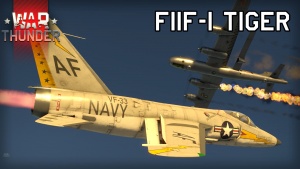
When fighting the Shenyang F-5 or MiG-17AS or any other planes with missiles, it is best to not allow them to get behind the Tiger (your excellent cockpit visibility will help you detect when it happens). While they can be avoided, it is still risky and can lead to the plane slowing down and becoming an easy target for higher manoeuvrable fighters. One of the tactics is to make the enemy waste all his missiles by baiting them into launching the missile by running away and pulling a few G (depends on the speed, 4-5G works at ~700 km/h TAS, at higher speed you need more G), then avoiding them. For example both MiG-17 variants are able to carry only two of them. Once they run out of missiles, deal with them like with any other jet fighter. The only exception is the Yak-38: it also carries the R-60 missiles which have much higher tracking ability and can pull much more G but its manoeuvrability is even worse, so it can be outturned in any situation, especially after forcing it to prolonged turning: its energy retention is awful.
There are a few fighters that can be beaten by dogfighting at high speed, most of British fighters like the Scimitar or Hunter F.1 are worse at turning, especially at low speed. They also will not be able to escape: in the case of the Scimitar the level speed is almost the same, but it does have better climb rate performance and acceleration. When it starts to run, it is the best to launch the missile and force it to slow down. Both Supermarine Swifts are also inferior to the F11F in both turn rate and flight performance. The other nation with fighters worse at both turning and flight performance is France, the Super Mystere B2 and Etendard IVM still can pose a treat, both are able to carry missiles. The first one has an engine with afterburner, this way it can be spotted from a few kilometres away, it is also as fast as the F11F. The other one does not have access to it, however its climbing performance and level acceleration are superior to the Super Mystere and the Tiger.
Radars
The F11F-1 is equipped with an AN/APG-30 rangefinding radar, located in the nose of the aircraft. It will automatically detect other planes within the scanning area and display the range to the closest target. It is linked with a gyro gunsight and can help with aiming at close range.
| AN/APG-30 - Rangefinding radar | |||
|---|---|---|---|
| Maximum Tracking Range |
Minimum Tracking Range |
Azimuth Tracking Angle |
Elevation Tracking Angle |
| 2,750 m | 300 m | ±9° | ±9° |
Pros and cons
Pros:
- Great top speed
- Outstanding roll rate
- Has access to 4 AIM-9B sidewinder missiles
- Adequate suspended payload options for ground attack
- Decent armament
Cons:
- No takeoff or combat flaps, only landing flaps
- Bad turn time
- Loses a lot of speed in low and medium speed turns
- Needs a lot of runway to land
- Can rip wings at high speeds
- Weak structural integrity
History
The F11F Tiger was a carrier-based fighter aircraft used by the US Navy between 1955 and 1968. The aircraft was originally designed as an advanced derivative of the F9F Panther, but soon became a completely new design. The aircraft has the distinction of being the second supersonic navy aircraft, after the F4D Skyray. F11F aircraft served in operational units between 1957 and 1961, while trainer variants served into the early 1970s. The aircraft also enjoyed a long service life with the Blue Angels demonstration team, which used the aircraft from 1957 to 1968 when it was superseded by the McDonnell Douglas F-4 Phantom II.
Design and Development
The F11F Tiger had its origins in an advanced variant of the F9F Panther, by incorporating new technological advances to allow for higher speeds. However, the design had changed so much by 1953 that the aircraft no longer bore any resemblance to its older cousin, despite having an initial designation of F9F-9. The aircraft had full-length leading-edge slats and rear flaps on the swept wing, and utilized a pair of spoilers for roll control. The aircraft also had an all-moving tail to improve turning ability at higher speeds. It was fitted with the Wright J65 turbojet, a license-built version of the Armstrong-Siddeley Sapphire.
The US Navy had considerable interest in such a fighter, and thus, two prototypes were ordered. The aircraft almost went supersonic on the first flight, despite having a non-afterburning engine due to delays with the readiness of the J65. The second prototype was fitted with the afterburning J65, and became the second supersonic US Navy aircraft after the F4D Skyray. Carrier trials were started in 1956, when an F11F-1 Tiger landed on the deck of the USS Forrestal.
Operational Service
The F11F-1 Tiger entered service in early 1957, operating from Essex-class and Forrestal-class carriers. However, it was retired in 1961 after just four years of service, as the aircraft's performance was inferior to the F8U Crusader. A total of 199 F11F-1 Tigers were built, while the remaining 231 aircraft on order were cancelled. The F11F-1 Tiger also enjoyed a longer service life with the Blue Angels, which started using them from 1957. They would fly with the demonstration team until 1968, when they were replaced by the F-4 Phantom II.
The F11F-1 Tiger also had the unfortunate distinction of being the first jet aircraft to shoot itself down. In 1956, during a test-firing of the aircraft's cannons, test pilot Tom Attridge fired the aircraft's cannons in a dive, only to run into the bullets as the F11F's trajectory passed the rounds. The aircraft was damaged, forcing him to crash-land; he survived. Following the end of operational service, several F11F-1 aircraft were used as advanced trainers to prepare pilots for flying supersonic aircraft; these trainers went on to serve into the 1970s, when they were retired and replaced with the T-38 Talon.
Media
- Skins
- Videos
See also
External links
| Grumman Aircraft Engineering Corporation | |
|---|---|
| Aircraft | |
| Fighters | |
| F3F | F3F-2 · Galer's F3F-2 |
| F4F Wildcat | F4F-3 · F4F-4 |
| XF5F Skyrocket | XF5F · XP-50 |
| F6F Hellcat | F6F-5 · F6F-5N |
| F7F Tigercat | F7F-1 · F7F-3 |
| F8F Bearcat | F8F-1 · F8F-1B |
| Jet Fighters | |
| F9F Panther/Cougar | F9F-2 · F9F-5 · F9F-8 |
| F-11 Tiger | F11F-1 |
| F-14 Tomcat | F-14A Early · F-14B |
| Jet Strike Aircraft | |
| A-6 Intruder | A-6E TRAM |
| Bombers | TBF-1C |
| Export | ▄Martlet Mk IV · ▄F6F-5 · ▄F6F-5N · ▄F8F-1B · ▄Avenger Mk II · ▄Hellcat Mk II |
| ▄F-14A IRIAF | |
| Naval Vehicles | |
| Patrol Gunboat Hydrofoil (PGH) | USS Flagstaff |
| USA jet aircraft | |
|---|---|
| Fighters | |
| F9F | F9F-2 · F9F-5 · F9F-8 |
| F-80 | F-80A-5 · F-80C-10 |
| F-84 | F-84B-26 · F-84F · F-84G-21-RE |
| F-86 | F-86A-5 · F-86F-25 · F-86F-2 · F-86F-35 |
| F-89 | F-89B · F-89D |
| F-100 | F-100D |
| F-104 | F-104A · F-104C |
| F-4 | F-4C Phantom II · F-4E Phantom II · F-4J Phantom II · F-4S Phantom II |
| F-5 | F-5A · F-5C · F-5E · F-20A |
| F-8 | F8U-2 · F-8E |
| F-14 | F-14A Early · ▄F-14A IRIAF · F-14B |
| F-15 | F-15A · F-15C MSIP II · F-15E |
| F-16 | F-16A · F-16A ADF · F-16C |
| Other | P-59A · F2H-2 · F3D-1 · F3H-2 · F4D-1 · F11F-1 |
| Strike Aircraft | |
| FJ-4 | FJ-4B · FJ-4B VMF-232 |
| A-4 | A-4B · A-4E Early |
| A-7 | A-7D · A-7E · A-7K |
| AV-8 | AV-8A · AV-8C · AV-8B Plus · AV-8B (NA) |
| A-10 | A-10A · A-10A Late · A-10C |
| F-111 | F-111A · F-111F |
| Other | A-6E TRAM · F-105D · F-117 |
| Bombers | |
| B-57 | B-57A · B-57B |


